Analysis of Land-Use Change in Shortandy District in Terms of Sustainable Development
Abstract
1. Introduction
2. Materials and Methods
2.1. Study Area
2.2. Data
2.3. Methods
3. Results
3.1. Land Use Changes in Shortandy District
3.2. Analyze of Sustainable Development of Shortandy District
4. Discussion
5. Conclusions
- on the spatiotemporal change in the structure of the LULC using the instrumental analysis method (RS and GIS);
- on the development of the economic, environmental and social potential of the AOI with the use of statistical indicators transformed and combined into three target groups of sustainable development indicators; specifically, economic, ecological and social characteristics.
Author Contributions
Funding
Acknowledgments
Conflicts of Interest
References
- FAO. The Future of Food and Agriculture—Trends and Challenges; Food and Agriculture Organization of the United Nations: Rome, Italy, 2017; 180p, Available online: http://www.fao.org/3/a-i6583e.pdf (accessed on 3 May 2020).
- World Urbanization Prospects: The 2018 Revision; United Nations, Department of Economic and SocialAffairs, Population Division: New York, NY, USA, 2019; 126p, Available online: http://www.fao.org/3/I8429EN/i8429en.pdf (accessed on 3 May 2020).
- FAO. The Future of Food and Agriculture—Alternative Pathways to 2050; FAO: Rome, Italy, 2018; 224p. [Google Scholar]
- Alam, A. Soil Degradation: A Challenge to Sustainable Agriculture. Int. J. Sci. Res. Agric. Sci. 2014, 1, 50–55, ISSN 2345-6795. [Google Scholar] [CrossRef]
- Mirzabaev, A. Land Degradation and Sustainable Land Management Innovations in Central Asia. In Technological and Institutional Innovations for Marginalized Smallholders in Agricultural Development; Gatzweiler, F., von Braun, J., Eds.; Springer: Cham, Switzerland, 2016. [Google Scholar] [CrossRef]
- Keesstra, S.; Mol, G.; de Leeuw, J.; Okx, J.; Molenaar, C.; de Cleen, M.; Visser, S. Soil-Related Sustainable Development Goals: Four Concepts to Make Land Degradation Neutrality and Restoration Work. Land 2018, 7, 133. [Google Scholar] [CrossRef]
- Panpatte, D.G.; Jhala, Y.K. Soil Fertility Management for Sustainable Development; Springer: Singapore, January 2019; 303p. [Google Scholar] [CrossRef]
- UN 2030 Agenda for Sustainable Development and SDGs. Available online: https://chemicalleasing.org/concept/policy-background/un-2030-agenda-sustainable-development-and-sdgs (accessed on 3 May 2020).
- International Initiative on Water Quality (IIWQ). Available online: https://en.unesco.org/waterquality-iiwq/wq-challenge (accessed on 3 May 2020).
- Devisscher, T.; Konijnendijk, C.; Nesbitt, L.; Lenhart, J.; Salbitano, F.; Cheng, Z.C.; Lwasa, S.; van den Bosch, M. SDG 11: Sustainable Cities and Communities—Impacts on Forests and Forest-Based Livelihoods; Cambridge University Press: Cambridge, UK, 2019; pp. 349–385. Available online: https://www.cambridge.org/core/services/aop-cambridge-core/content/view/82DBFCBBB457D4D1DD460FB5F075B5AD/9781108486996c11_349-385.pdf/sdg_11_sustainable_cities_and_communities_impacts_on_forests_and_forestbased_livelihoods.pdf (accessed on 3 May 2020).
- Foley, J.A.; De Fries, R.; Asner, G.P.; Barford, C.; Bonan, G.; Carpenter, S.R.; Chapin, F.S.; Coe, M.T.; Daily, G.C.; Gibbs, H.K.; et al. Global consequences of land use. Science 2005, 309, 570–574. [Google Scholar] [CrossRef] [PubMed]
- Sala, O.E.; Chapin, F.S., III; Armesto, J.J.; Berlow, E.; Bloomfield, J.; Dirzo, R.; Huber-Sanwald, E.; Huenneke, L.F.; Jackson, R.B.; Kinzig, A.; et al. Global biodiversity scenarios for the year 2100. Science 2000, 287, 1770–1774. [Google Scholar] [CrossRef] [PubMed]
- Song, X.P.; Hansen, M.C.; Stehman, S.V.; Potapov, P.V.; Tyukavina, A.; Vermote, E.F.; Townshend, J.R. Global land change from 1982 to 2016. Nature 2018, 560, 639–643. [Google Scholar] [CrossRef] [PubMed]
- Turner, B.; Meyer, W.B.; Skole, D.L. Global land use/land cover change: Towards an integrated study. AMBIO 1994, 23, 91–95. [Google Scholar]
- Feranec, J.; Soukup, T.; Hazeu, G.; Jaffrain, G. (Eds.) European Landscape Dynamics: CORINE Land Cover Data, 1st ed.; CRC Press: Boca Raton, FL, USA, 2016; ISBN 9781315372860. [Google Scholar]
- Szumacher, I.; Pabjanek, P. Temporal Changes in Ecosystem Services in European Cities in the Continental Biogeographical Region in the Period from 1990–2012. Sustainability 2017, 9, 665. [Google Scholar] [CrossRef]
- Seto, K.C.; Fragkias, M.; Güneralp, B.; Reilly, M.K. A meta-analysis of global urban land expansion. PLoS ONE 2011, 6, e23777. [Google Scholar] [CrossRef]
- Rennings, K.; Wiggering, H. Steps towards indicators of sustainable development: Linking economic and ecological concepts. Ecol. Econ. 1997, 20, 25–36. [Google Scholar] [CrossRef]
- Kuik, O.; Verbruggen, H. In Search of Indicators of Sustainable Development; Media, B.V., Ed.; Sprigner—Science + Business: Dordrecht, The Netherlands, 2012. [Google Scholar]
- Hák, T.; Moldan, B.; Dahl, A.L. Sustainability Indicators: A Scientific Assessment; Scientific Committee on Problems of the Environment (SCOPE): Washington, DC, USA, 2007. [Google Scholar]
- Steurer, R.; Hametner, M. Objectives and Indicators in Sustainable Development Strategies: Similarities and Variances across Europe. Sustain. Dev. 2013, 21, 224–241. [Google Scholar] [CrossRef]
- Gibas, P.; Majorek, A. Analysis of Land-Use Change between 2012–2018 in Europe in Terms of Sustainable Development. Land 2020, 9, 46. [Google Scholar] [CrossRef]
- Blaschke, T.; Hay, G.J.; Kelly, M.; Lang, S.; Hofmann, P.; Addink, E.; Feitosa, Q.R.; van der Meer, F.; van der Werff, H.; van Coillie, F.; et al. Geographic Object-Based Image Analysis -Towardsanewparadigm. ISPRS J. Photogramm. Remote Sens. 2014, 87, 180–191. [Google Scholar] [CrossRef] [PubMed]
- Ma, L.; Li, M.; Ma, X.; Cheng, L.; Du, P.; Liu, Y. Areviewofsupervisedobject-basedland-coverimageclassification. ISPRS J. Photogramm. Remote Sens. 2017, 130, 277–293. [Google Scholar] [CrossRef]
- Atzberger, C. Advancesin Remote Sensing of Agriculture: Context Description, Existin Operational Monitoring Systems and Major Information Needs. Remote Sens. 2013, 5, 949–981. [Google Scholar] [CrossRef]
- Land Use and Land Cover Change. Available online: https://nca2014.globalchange.gov/report/sectors/land-use-and-land-cover-change (accessed on 3 May 2020).
- Calicioglu, O.; Flammini, A.; Bracco, S.; Bellu, L.; Sims, R. The Future Challenges of Food and Agriculture: AnIntegrated Analysis of Trends and Solutions. Sustainability 2019, 11, 222. [Google Scholar] [CrossRef]
- Global Land Cover Characterization (GLCC). Available online: http://www.fao.org/land-water/land/land-governance/land-resources-planning-toolbox/category/details/en/c/1036354/ (accessed on 3 May 2020).
- Wulder, M.A.; Coops, N.C.; Roy, D.P.; White, J.C.; Hermosilla, T. Land cover 2.0. Int. J.Remote Sens. 2018, 39, 4254–4284. [Google Scholar] [CrossRef]
- CORINE Land Cover. Available online: https://land.copernicus.eu/pan-european/corine-land-cover (accessed on 8 May 2020).
- Bielecka, E.; Jenerowicz, A. Intellectual Structure of CORINE Land Cover Research Applications in Web of Science: A Europe-Wide Review. Remote Sens. 2019, 11, 2017. [Google Scholar] [CrossRef]
- The World Commission on Environment and Development. Report of the World Commission on Environment and Development: Our Common Future; Oxford University Press: Oxford, UK, 1987; p. 16. [Google Scholar]
- About the Sustainable Development Goals. Available online: https://www.un.org/sustainabledevelopment/sustainable-development-goals/ (accessed on 3 May 2020).
- Braimoh, A.K.; Osaki, M. Land-use change and environmental sustainability. Sustain. Sci. 2010, 5, 5–7. [Google Scholar] [CrossRef]
- Sandru, M.I.V.; Iatu, C.; Sandru, D.C.; Cimbru, D.G. Approaching Land Cover-Land Use Changes Using Statistical Data Validation for Urban Policies Improvement. J. Settl. Spat. Plan. 2017, 8, 119–129. [Google Scholar]
- Salata, S. Land use change analysis in the urban region of Milan. Manag. Environ. Qual. Int. J. 2017, 28, 879–901. [Google Scholar] [CrossRef]
- Karbetova, Z.; Karbetova, S.; Otyzbayeva, K.; Daribayeva, A.; Dulatbekova, Z.; Tastanbekova, K. Strategic Priorities and Challenges of Environmental Management in Kazakhstan. J. Adv. Res. Law Econ. 2016, 7, 1058–1065. [Google Scholar]
- Mezősi, G.; Meyer, B.C.; Bata, T.; Kovács, F.; Czúcz, B.; Ladányi, Z.; Blanka, V. Integrated Approach to Estimate Land Use Intensity for Hungary. J. Environ. Geogr. 2019, 12, 45–52. [Google Scholar] [CrossRef]
- Indicators of Sustainable Development: Guidelines and Methodologies, 3rd ed.; United Nations: New York, NY, USA, 2007; 99p, Available online: https://www.un.org/esa/sustdev/natlinfo/indicators/guidelines.pdf (accessed on 3 May 2020).
- Workshop on Environment Statistics in Support of the Implementation of the Framework for the Development of Environment Statistics. United Nations Statistics Division (UNSD). Land Cover and Land use in Environment Statistics. Arusha, Tanzania, 6–10 July 2015. 37p. Available online: https://unstats.un.org/unsd/ENVIRONMENT/envpdf/unsd_EAC_Workshop/Session%206b_Anand%20Land%20cover%20and%20land%20use%20in%20environment%20statistics.pdf (accessed on 3 May 2020).
- Alipbeki, O.; Alipbekova, C.; Sterenharz, A.; Toleubekova, Z.; Aliyev, M.; Mineyev, N.; Amangaliyev, K. A Spatiotemporal Assessment of Land Use and Land Cover Changes in Peri-Urban Areas: A Case Study of Arshaly District, Kazakhstan. Sustainability 2020, 12, 1556. [Google Scholar] [CrossRef]
- Thomas, M. Social, environmental and economic sustainability of Kazakhstan: A long-term perspective. Cent. Asian Surv. 2015, 34, 456–483. Available online: https://www.tandfonline.com/doi/full/10.1080/02634937.2015.1119552?scroll=top&needAccess=true (accessed on 3 May 2020). [CrossRef]
- Kazakhstan. Voluntary National Review 2019 on the Implementation of the 2030 Agenda for Sustainable Development. 2019. 159p. Available online: https://sustainabledevelopment.un.org/content/documents/23946KAZAKHSTAN_DNO__eng_4.Juli19.pdf (accessed on 3 May 2020).
- Sustainable Development Goal Indicators Website. Available online: https://unstats.un.org/sdgs/indicators/database/ (accessed on 3 May 2020).
- KGS. Available online: https://www.gharysh.kz/AboutKA_DZZ/ (accessed on 26 February 2020).
- Eisfelder, C.; Markus Niklaus, M.; Kuenzer, C. Net primary productivity in Kazakhstan, its spatio-temporal patterns and relation to meteorological variables. J. Arid Environ. 2014, 103, 17–30. [Google Scholar] [CrossRef]
- Kraemer, R.; Prishchepov, A.V.; Müller, D.; Kuemmerle, T.; Radelof, V.C.; Dara, A.; Terekhov, A.; Frühauf, M. Long-term agricultural land-cover change and potential for cropland expansion in the former Virgin Lands area of Kazakhstan. Environ. Res. Lett. 2015, 10, 054012. [Google Scholar] [CrossRef]
- Samarkhanov, K.; Abuduwaili, J.; Samat, A.; Issanova, G. The Spatial and Temporal Land Cover Patterns of the Qazaly Irrigation Zone in 2003–2018: The Case of Syrdarya River’s Lower Reaches, Kazakhstan. Sustainability 2019, 11, 4035. [Google Scholar] [CrossRef]
- Taibassarova, Z. Nazarbayev Detection of the Vegetation Change Cover Using Landsat TM5 in the Burabay State National Natural Park, Kazakhstan; Nazarbayev University: Astana, Kazakhstan. Available online: https://nur.nu.edu.kz/bitstream/handle/123456789/3190/Taibassarova.PDF?sequence=1&isAllowed=y (accessed on 18 February 2020).
- Ilyassova, A.; Kantakumar, N.L.; Boyd, D. Urban growth analysis and simulations using cellular automataand geo-informatics: Comparison between Almaty and Astana in Kazakhstan. Geocarto Int. 2019. Corpus ID: 181852613. [Google Scholar] [CrossRef]
- Qi, J.; Tao, S.; Pueppke, S.G.; Espolov, T.E.; Beksultanov, M.; Chen, X.; Xiumin Cai, X. Changes in land use/land cover and net primary productivity in the transboundary Ili-Balkhash basin of Central Asia, 1995–2015. Environ. Res. Commun. 2020, 2, 011006. [Google Scholar] [CrossRef]
- SRTM Data. Available online: http://srtm.csi.cgiar.org/ (accessed on 15 October 2019).
- Agroclimatic Resources of the Akmola Oblast: A Scientific Applied Reference. Available online: https://ingeo.kz/wp-content/uploads/2017/11/%D0%90%D0%B3%D1%80%D0%BE%D0%BA%D0%BB%D0%B8%D0%BC%D0%B0%D1%82%D0%B8%D1%87%D0%B5%D1%81%D0%BA%D0%B8%D0%B5-%D1%80%D0%B5%D1%81%D1%83%D1%80%D1%81%D1%8B-%D0%90%D0%BA%D0%BC%D0%BE%D0%BB%D0%B8%D0%BD%D1%81%D0%BA%D0%BE%D0%B9-%D0%BE%D0%B1%D0%BB%D0%B0%D1%81%D1%82%D0%B82.pdf (accessed on 3 May 2020). (In Russia).
- The Official Internet Resource of the Shortandy District. Available online: http://shortandy.akmo.gov.kz/page/read/Obcshie_svedeniya.html (accessed on 3 May 2020).
- Shortandy (Shortandy District). Available online: http://ru.encyclopedia.kz/index.php/%D0%A8%D0%BE%D1%80%D1%82%D0%B0%D0%BD%D0%B4%D1%8B_(%D0%A8%D0%BE%D1%80%D1%82%D0%B0%D0%BD%D0%B4%D0%B8%D0%BD%D1%81%D0%BA%D0%B8%D0%B9_%D1%80%D0%B0%D0%B9%D0%BE%D0%BD) (accessed on 3 May 2020).
- United States Geological Survey. Available online: https://earthexplorer.usgs.gov/ (accessed on 18 February 2020).
- The Dynamics of the Main Socio-Economic Indicators. Available online: https://old.stat.gov.kz/faces/akmola/reg_main/regDinamo?_afrLoop=14341087210159499#%40%3F_afrLoop%3D14341087210159499%26_adf.ctrl-state%3Dg39cu191d_204 (accessed on 3 May 2020).
- National Report on the State of the Environment and the Use of Natural Resources: 2011–2014. Available online: http://ecogosfond.kz/wp-content/uploads/2018/03/NDSOS_2011-2014.pdf (accessed on 3 May 2020).
- Bossard, M.; Feranec, J.; Otahel, J. CORINE Land Cover Technical Guide-Addendum. 2000. Technical Report No. 40/2000. Copenhagen. Available online: https://www.eea.europa.eu/publications/tech40add (accessed on 9 January 2020).
- Kaul, H.A.; Sopan, I.T. Land Use Land Cover Classification and Change Detection Using High-ResolutionTemporal Satellite Data. J. Environ. 2012, 1, 146–152. [Google Scholar]
- Nguyen, T.B.P.; Zhang, X.; Wu, W.; Liu, H. Land Use/Land Cover Changes from 1995 to 2017 in Trang Bang, Southern Vietnam. Agric. Sci. 2019, 10, 413–422. [Google Scholar] [CrossRef][Green Version]
- Lurie, I.K.; Kosikov, A.G. Theory and Practice of Digital Image Processing; Berlyant, A.M., Ed.; Scientific World: Moscow, Russia, 2003; 168p. (In Russia) [Google Scholar]
- Semenova, N.N.; Busalova, S.G.; Eremina, O.I.; Makeikina, S.M.; Ivanova, I.A. Assessment of Sustainable Development of Rural Areas of Russia. Indian J. Sci. Technol. 2016, 9. [Google Scholar] [CrossRef][Green Version]
- Green Belt of Astana. Available online: http://astana.gov.kz/en/page/zelenyy_poyas_astany (accessed on 3 December 2019).
- Ministry of National Economy Republic of Kazakhstan. Statistics Committee. Available online: https://old.stat.gov.kz/faces/akmola/regPublications?_afrLoop=14325556427266828#%40%3F_afrLoop%3D14325556427266828%26_adf.ctrl-state%3Dtqmb1bxpa_43 (accessed on 3 May 2020).
- Weiss, M.; Jacob, F.; Duveiller, G. Remote sensing for agricultural applications: A meta-review. Remote Sens. Environ. 2019, 1–39. [Google Scholar] [CrossRef]
- Gomez, C.; White, J.C.; Wulder, M.A. Optical remotely sensed time series data for land cover classification: Areview. ISPRS J. Photogramm. Remote Sens. 2016, 116, 55–72. [Google Scholar]
- CORINE Land Cover—CLC. Available online: http://clc.gios.gov.pl/index.php/o-clc/program-clc (accessed on 3 May 2020).
- Nakamura, M.; Pendlebury, D.; Schnell, J.; Szomszor, M. Navigating the Structure of Research on Sustainable Development Goals; Clarivate Analytics: Philadelphia, PA, USA, 2019. [Google Scholar]
- Debolini, M.; Valette, E.; François, M.; Jean-Pierre, C. Mapping land use competition in the rural–urban fringe and future perspectives on land policies: A case study of Meknès (Morocco). Land Use Policy 2015, 47, 373–381. [Google Scholar] [CrossRef]
- Jiang, L.; Deng, X.; Setoc, K.C. The impact of urban expansion on agricultural land use intensity in China. Land Use Policy 2013, 35, 33–39. [Google Scholar] [CrossRef]
- Rimal, B. Urbanization and the Decline of Agricultural Land in Pokhara Sub-metropolitan City, Nepal. J. Agric. Sci. 2013, 5, 12p. [Google Scholar] [CrossRef]
- Pandey, B.; Zhang, Q.; Seto, K.C. Time series analysis of satellite data to characterize multiple land use transitions: A case study of urban growth and agricultural land loss in India. J. Land Use Sci. 2018, 13, 221–237. [Google Scholar] [CrossRef]
- Fenta, A.A.; Hiroshi, Y.; Haregeweyn, N.; Belay, A.S.; Hadush, Z.; Gebremedhin, M.A.; Mekonnen, G. The dynamics of urban expansion and land use/land cover changes using remote sensing and spatial metrics: The case of Mekelle City of northern Ethiopia. Int. J. Remote Sens. 2017, 38, 4107–4129. [Google Scholar] [CrossRef]
- Akber, A.K.; Wahidur, R.I.; Atikul, R.; Munsur, R.M. Impact of land use change on ecosystem services of southwest coastal Bangladesh. J. Land Use Sci. 2018, 13, 238–250. [Google Scholar] [CrossRef]
- Wadduwage, S.; Millington, A.; Crossman, N.D.; Sandhu, H. Agricultural Land Fragmentation at Urban Fringes: An Application of Urban-To-Rural Gradient Analysis in Adelaide. Land 2017, 6, 28. [Google Scholar] [CrossRef]
- Essien, E.; Cyrus, S. Detection of Urban Development in Uyo (Nigeria) Using Remote Sensing. Land 2019, 8, 102. [Google Scholar] [CrossRef]
- Indicators of Sustainable Development: Guidelines and Methodologies. 2007. 315p. Available online: https://sustainabledevelopment.un.org/content/documents/indisd-mg2001.pdf (accessed on 3 May 2020).
- Zharova, L.; Khlobystov, I.; Eremeeva, N. Indicators of sustainable development in framework of environmental policy: Experience of eastern neighbors. Mind J. 2016. Available online: https://www.researchgate.net/publication/308379579_INDICATORS_OF_SUSTAINABLE_DEVELOPMENT_IN_FRAMEWORK_OF_ENVIRONMENTAL_POLICY_EXPERIENCE_OF_EASTERN_NEIGHBORS (accessed on 23 February 2020).
- Hopwood, B.; Mellor, M.; O’Brien, G. Sustainable development: Mapping different approaches sustainabledevelopment. Sustain.Dev. 2005, 13, 38–52. [Google Scholar] [CrossRef]
- Wu, J. Linking landscape, land system and design approaches to achieve sustainability. J. Land Use Sci. 2019, 14, 173–179. [Google Scholar] [CrossRef]
- Zoomers, A. Globalisation and the foreignisation of space: Seven processes driving the current global land grab. J. Peasant Stud. 2010, 37, 429–447. [Google Scholar] [CrossRef]
- Bren d’Amour, C.; Reitsma, F.; Baiocchi, G.; Barthel, S.; Güneralp, B.; Erb, K.H.; Haberl, H.; Creutzig, F.; Seto, K.C. Future urban land expansion and implications for global croplands. Proc. Natl. Acad. Sci. USA 2017, 114, 8939–8944. Available online: https://www.pnas.org/content/pnas/114/34/8939.full.pdf (accessed on 3 May 2020). [CrossRef]
- The Future of Food and Farming: Challenges and choices for global sustainability. Foresight. Final Project. Report. The Government Office for Science, London. 2011. Available online: https://assets.publishing.service.gov.uk/government/uploads/system/uploads/attachment_data/file/288329/11-546-future-of-food-and-farming-report.pdf (accessed on 3 May 2020).
- Guastella, G.; Pareglio, S. Sustainable Development of Rural Areas: Using Urban Patterns to Map the Agricultural Systems. Agric. Agric. Sci. Procedia 2016, 8, 88–98. Available online: https://reader.elsevier.com/reader/sd/pii/S2210784316300122?token=BD879BA7A4435EF533989DBBA4B2A3B13F402B510130E9518DFD41F01C5F5D7728667F3CF4A86ADAF92CCBB8BFA343BB (accessed on 3 May 2020). [CrossRef]
- Wadduwage, S. Peri-urban agricultural land vulnerability due to urban sprawl—A multi-criteria spatially-explicit scenario analysis. J. Land Use Sci. 2018, 13, 358–374. [Google Scholar] [CrossRef]
- Neimark, B.; Toulmin, C.; Batterbury, S. Peri-urban land grabbing? dilemmas of formalising tenure and land acquisitions around the cities of Bamako and Ségou, Mali. J. Land Use Sci. 2018, 13, 319–324. [Google Scholar] [CrossRef]
- Sipilova, V.; Ostrovska, I.; Jermolajeva, E.; Aleksejeva, L.; OLehnovics, D. Evaluation of Sustainable Development in Rural Territories in Latgale Region (Latvia) by Using the Conception of Smart Specialization. J. Teach. Educ. Sustain. 2017, 19, 82–105. [Google Scholar] [CrossRef]
- Stukach, V.F.; Saparova, G.K.; Sultanova, G.T. Infrastructure of Agriculture of Kazakhstan: Dynamics of Agricultural Production, Interaction of Industrial and Social Spheres. MPRA Paper 96291. 20p. Available online: https://mpra.ub.uni-muenchen.de/96291/1/MPRA_paper_96291.pdf (accessed on 3 May 2020).
- Russell, A.; Ghalaieny, M.; Gazdiyeva, B.; Zhumabayeva, S.; Kurmanbayeva, A.; Akhmetov, K.K.; Mukanov, Y.; McCann, M.; Ali, M.; Tucker, A.; et al. A Spatial Survey of Environmental Indicators for Kazakhstan: An Examination of Current Conditions and Future Needs. Review. Int. J. Environ. Res. 2018, 14p. [Google Scholar] [CrossRef]
- Tokbergenova, A.; Kiyassova, L.; Kairova, S. Sustainable Development Agriculture in the Republic of Kazakhstan. Review. Pol. J. Environ. Stud. 2018, 27, 1923–1933. [Google Scholar] [CrossRef]
- Tasmaganbetov, A.B.; Abayev, A.A.; Rahmanova, A.S.; Tleukabylova, K.B. Theoretical and methodlogical bases of assessment of sustainable development of rural areas. Ser. Econ. 2019, 4, 8p. Available online: http://rep.ksu.kz/bitstream/handle/data/9323/%d0%ad%d0%ba-2019-4-67-74.pdf?sequence=1&isAllowed=y (accessed on 3 May 2020).
- Lescheva, M.G.; Ivolga, A.G.; Labenko, O.M. Special methodological aspects of economic analysis for rural territories development. Actual Probl. Econ. 2014, 159, 432–439. [Google Scholar]
- Kusakina, O.N.; Dykan, Y.A. Methodology for assessing the sustainable development of rural areas. Fundam. Res. 2015, 748–752. Available online: https://www.fundamental-research.ru/ru/article/view?id=38335 (accessed on 3 May 2020). (In Russia).
- Merenkova, I.N.; Medkov, A.N. Formation of the mechanism of sustainable development of rural areas on the basis of their overall assessment. FES Financ. Econ. Strategy 2011, 5, 53–57. [Google Scholar]
- Analysis and Forecast of Parameters of Transition to Sustainable Development. Available online: http://bibliotekar.kz/istorija-kazahstana-za-11-klass-hrestoma/1-2-analiz-i-prognoz-parametrov-perehoda.html (accessed on 3 May 2020). (In Russia).
- Maksimov, M. Kazakhstan in 2020–2024: Three Scenarios. Available online: https://www.zakon.kz/4989348-kazahstan-v-2020-2024-gody-tri.html (accessed on 3 May 2020). (In Russia).
- Forecast of Socio-Economic Development for 2020–2024. 27 August 2019. Official Information Resource of the Prime Minister of the Republic of Kazakhstan. Available online: https://primeminister.kz/ru/news/prognoz-socialno-ekonomicheskogo-razvitiya-na-2020-2024-gody-vvp-na-dushu-naseleniya-uvelichitsya-do-14-3-tyshttps://primeminister.kz/ru/news/prognoz-socialno-ekonomicheskogo-razvitiya-na-2020-2024-gody-vvp-na-dushu-naseleniya-uvelichitsya-do-14-3-tys (accessed on 3 May 2020). (In Russia).
- Analysts Forecast a Drop in Oil Prices to $ 5–10 per Barrel. 20 March 2020. Available online: https://zonakz.net/2020/03/20/analitiki-prognoziruyut-padenie-ceny-na-neft-do-5-10-za-barr/ (accessed on 3 May 2020). (In Russia).
- An Epidemic of the COVID-19 Virus Can Lead to a Recession. Available online: https://news.un.org/ru/story/2020/03/1374011 (accessed on 3 May 2020). (In Russia).
- The Forecast of Socio-Economic Development of Kazakhstan Will be Reviewed. 13 March 2020. Available online: https://kapital.kz/economic/85397/prognoz-sotsial-no-ekonomicheskogo-razvitiya-kazakhstana-peresmotryat.html (accessed on 3 May 2020). (In Russia).
- Forecast of the Long-Term Socio-Economic Development of the Russian Federation for the Period Until 2030. Available online: http://www.consultant.ru/document/cons_doc_LAW_144190/ (accessed on 3 May 2020). (In Russia).
- Prospects for Economic Development in Central Asia. ADB Forecast. Available online: http://cc-sauran.kz/rubriki/economika/233-perspektivy-ekonomicheskogo-razvitiya-v-centralnoy-azii-prognoz-abr.html (accessed on 3 May 2020). (In Russia).
- Sustainable Development Index. Available online: https://www.sustainabledevelopmentindex.org/time-series (accessed on 3 May 2020).
- Castanho, R.A.; Naranjo Gómez, J.M.; Kurowska-Pysz, J. Assessing Land Use Changes in Polish Territories: Patterns, Directions and Socioeconomic Impacts on Territorial Management. Sustainability 2019, 11, 1354. [Google Scholar] [CrossRef]

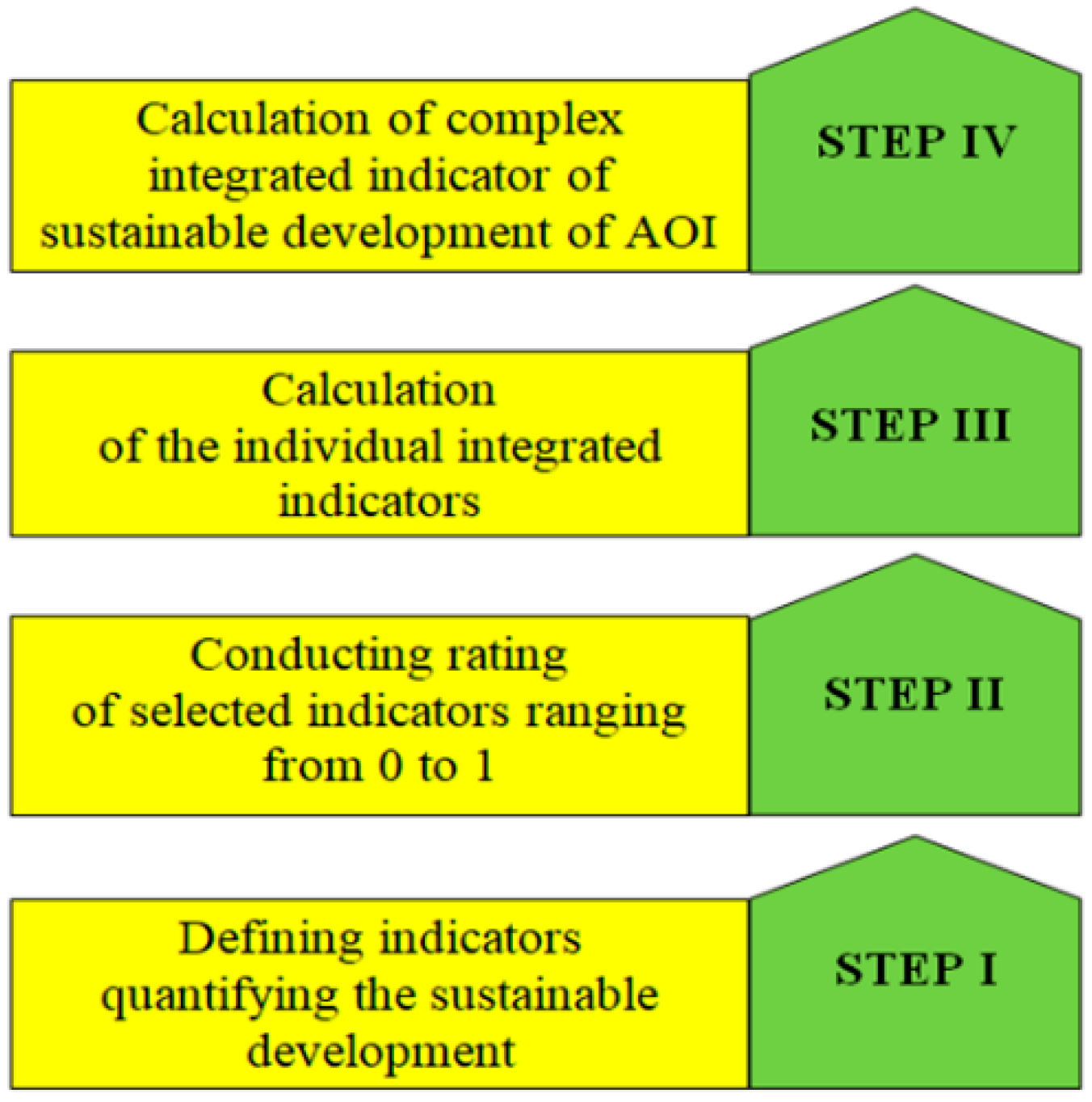
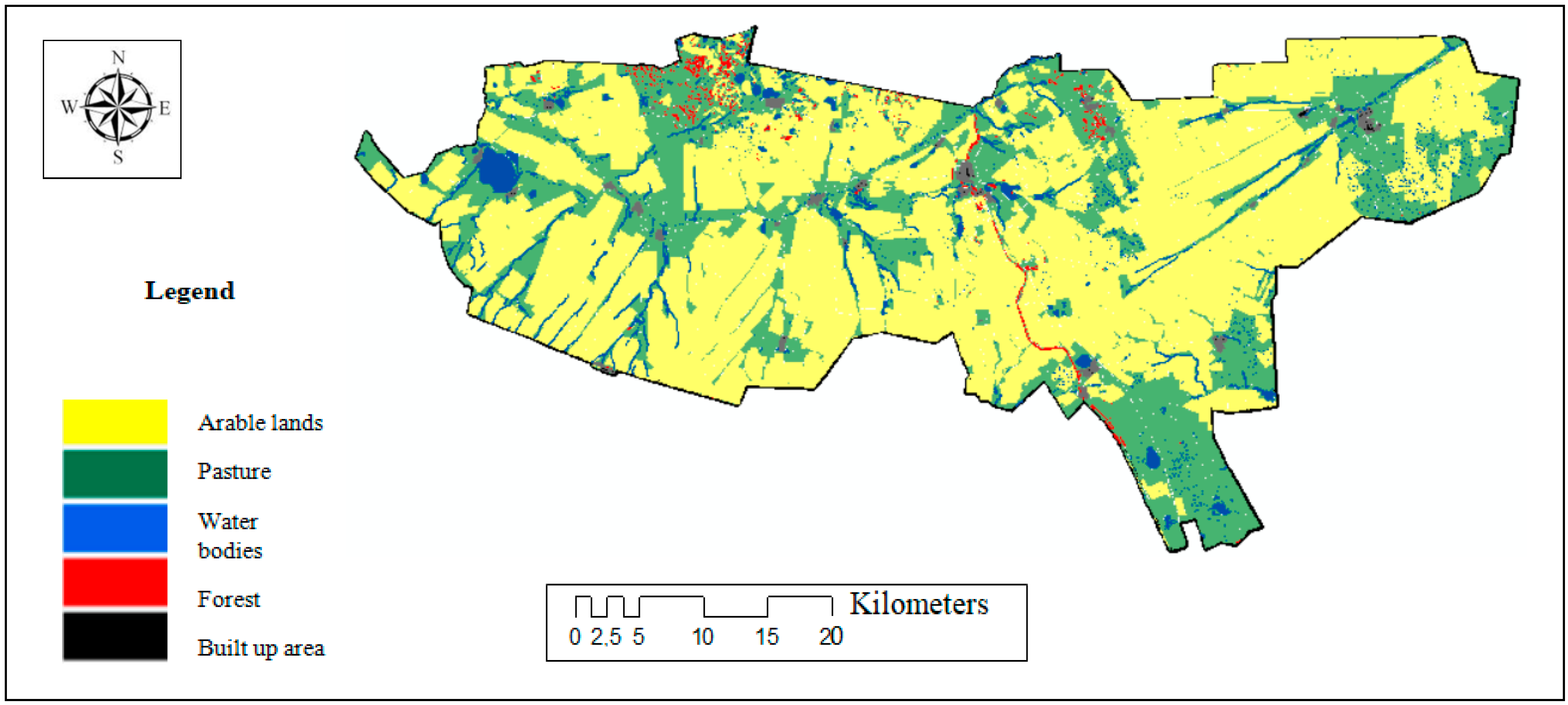
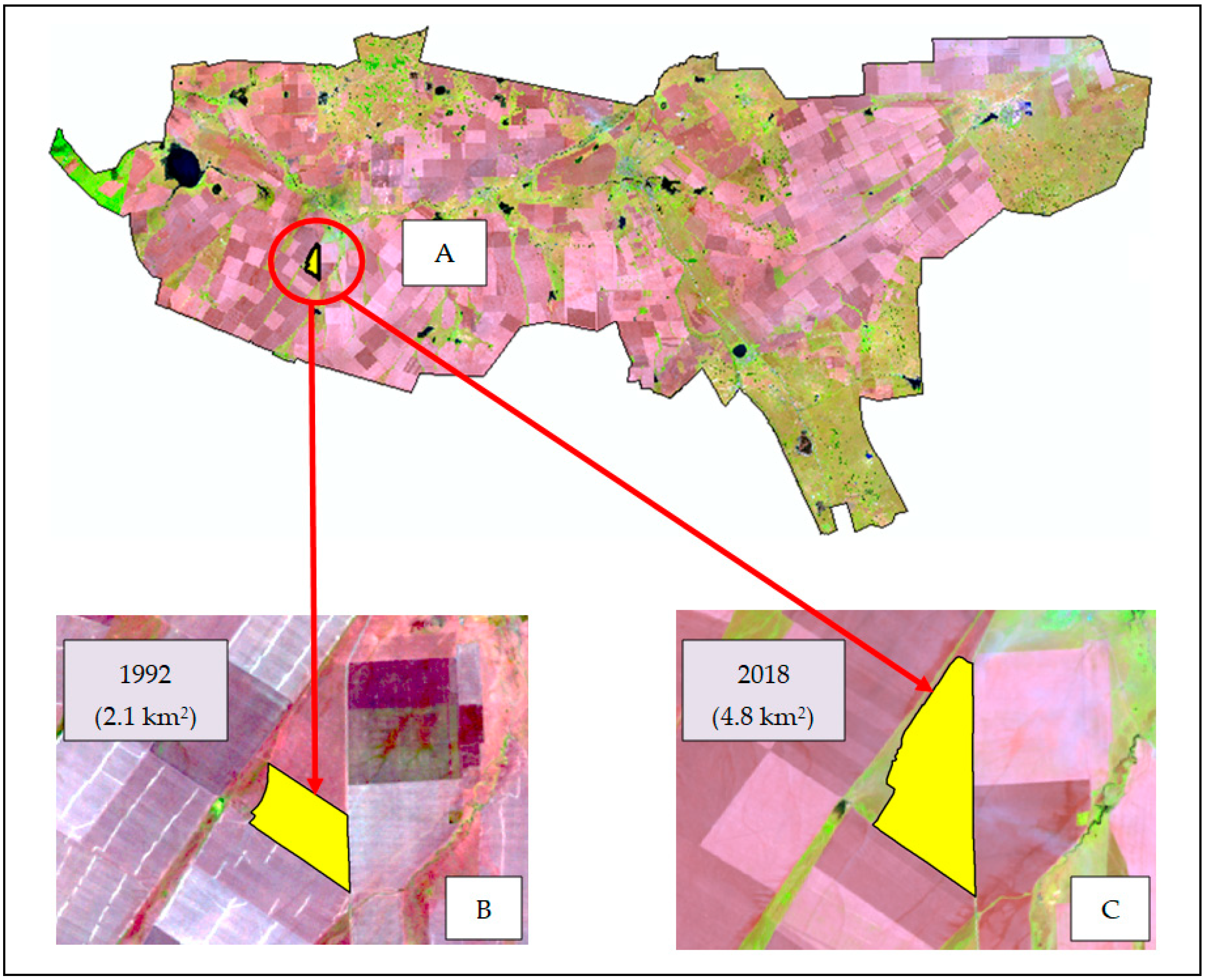
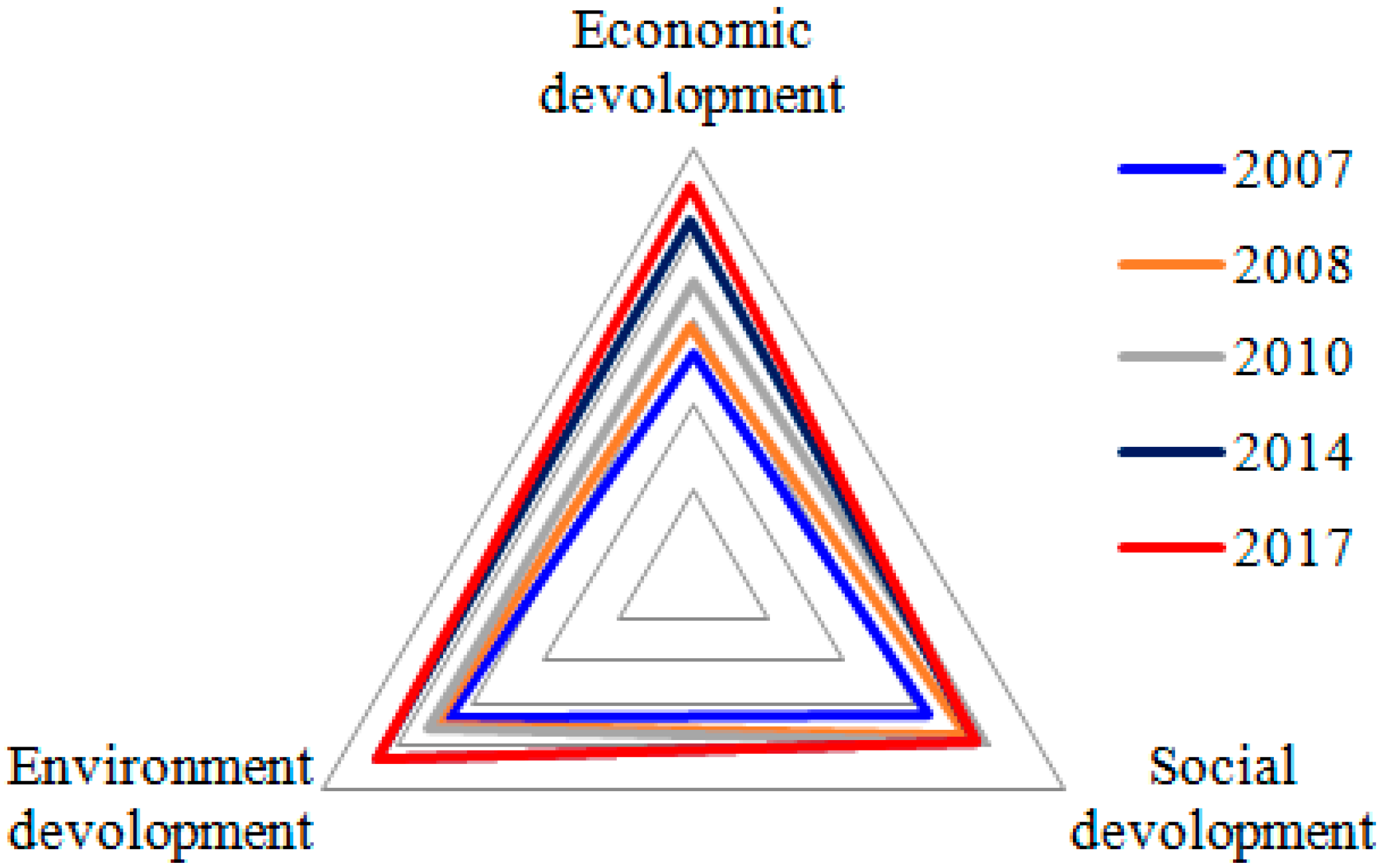
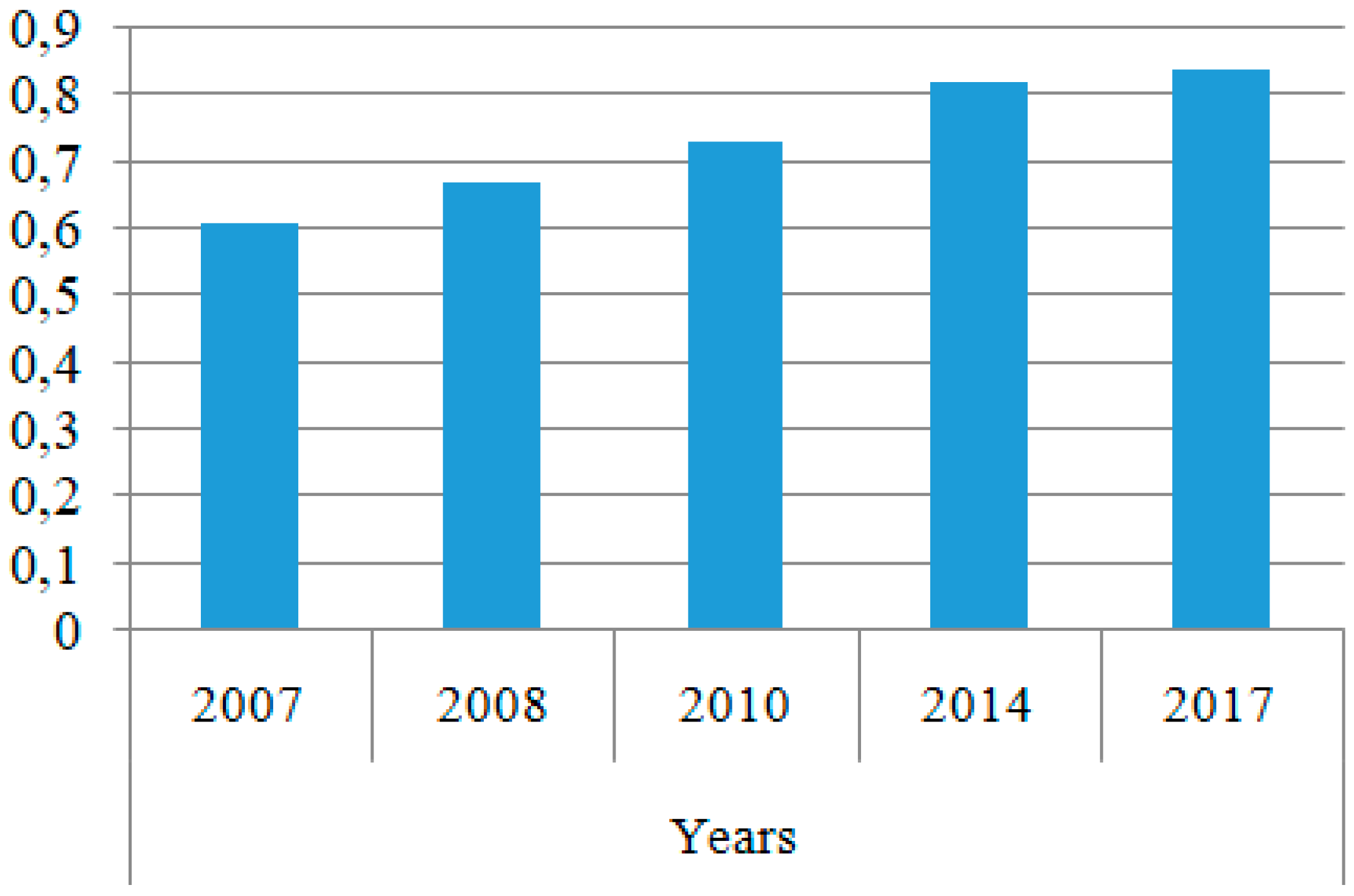
| Indicators | Indicator’s Title | Unit of Measurement |
|---|---|---|
| Economic | The volume of industrial output | million tenge |
| The volume of output of plant products | million tenge | |
| The volume of output of animal products | million tenge | |
| Investment in fixed capital | million tenge | |
| Social | Population; | thousand people |
| Ratio of the average monthly salary to the average wage in the economy as a hole | % | |
| Unemployment rate; | % | |
| Natural population migration coefficient | % | |
| Provision of rural population with drinking water | % | |
| The share of paved roads in the total length of roads | Per mille | |
| Environmental | The weighted average content of humus; | % |
| The weighted average content of easily mobile nitrogen | % | |
| The weighted average content of phosphorus; | % | |
| The weighted average content of exchangeable potassium | % |
| Land Use Classes | Area | |||||||
|---|---|---|---|---|---|---|---|---|
| 1992 | 1998 | 2008 | 2018 | |||||
| km2 | % | km2 | % | km2 | % | km2 | % | |
| Arable land | 3057.5 | 66.05 | 3057.70 | 66.06 | 3058.90 | 66.08 | 3074.00 | 66.41 |
| Pasture | 1378.50 | 29.78 | 1378.30 | 29.78 | 1374.40 | 29.69 | 1358.00 | 29.34 |
| Water | 125.00 | 2.70 | 125.00 | 2.70 | 125.00 | 2.70 | 125.00 | 2.70 |
| Forest | 36.70 | 0.79 | 36.70 | 0.79 | 37.40 | 0.81 | 37.60 | 0.81 |
| Built-up area | 31.10 | 0.67 | 31.10 | 0.67 | 33.10 | 0.72 | 34.20 | 0.74 |
| Total | 4628.80 | 100 | 4628.80 | 100 | 4628.80 | 100 | 4628.80 | 100 |
| Overall accuracy (%) | 93.1 | 92.2 | 94.7 | 94.0 | ||||
| Kappa | 0.85 | 0.83 | 0.89 | 0.89 | ||||
| Land Use Classes | Area of Difference (km2) | ||
|---|---|---|---|
| 1992–1998 | 1992–2008 | 1992–2018 | |
| Arable land | 0.20 | 1.40 | 16.50 |
| Pasture | −0.20 | −4.10 | −20.50 |
| Water | 0.00 | 0.00 | 0.00 |
| Forest | 0.00 | 0.70 | 0.90 |
| Built-up area | 0.00 | 2.00 | 3.10 |
| Year | Economic | Social | Environmental |
|---|---|---|---|
| 2007 | 0.56 | 0.64 | 0.66 |
| 2008 | 0.58 | 0.74 | 0.69 |
| 2010 | 0.69 | 0.78 | 0.71 |
| 2014 | 0.83 | 0.77 | 0.85 |
| 2017 | 0.91 | 0.77 | 0.85 |
© 2020 by the authors. Licensee MDPI, Basel, Switzerland. This article is an open access article distributed under the terms and conditions of the Creative Commons Attribution (CC BY) license (http://creativecommons.org/licenses/by/4.0/).
Share and Cite
Alipbeki, O.; Alipbekova, C.; Sterenharz, A.; Toleubekova, Z.; Makenova, S.; Aliyev, M.; Mineyev, N. Analysis of Land-Use Change in Shortandy District in Terms of Sustainable Development. Land 2020, 9, 147. https://doi.org/10.3390/land9050147
Alipbeki O, Alipbekova C, Sterenharz A, Toleubekova Z, Makenova S, Aliyev M, Mineyev N. Analysis of Land-Use Change in Shortandy District in Terms of Sustainable Development. Land. 2020; 9(5):147. https://doi.org/10.3390/land9050147
Chicago/Turabian StyleAlipbeki, Onggarbek, Chaimgul Alipbekova, Arnold Sterenharz, Zhanat Toleubekova, Saule Makenova, Meirzhan Aliyev, and Nursultan Mineyev. 2020. "Analysis of Land-Use Change in Shortandy District in Terms of Sustainable Development" Land 9, no. 5: 147. https://doi.org/10.3390/land9050147
APA StyleAlipbeki, O., Alipbekova, C., Sterenharz, A., Toleubekova, Z., Makenova, S., Aliyev, M., & Mineyev, N. (2020). Analysis of Land-Use Change in Shortandy District in Terms of Sustainable Development. Land, 9(5), 147. https://doi.org/10.3390/land9050147





